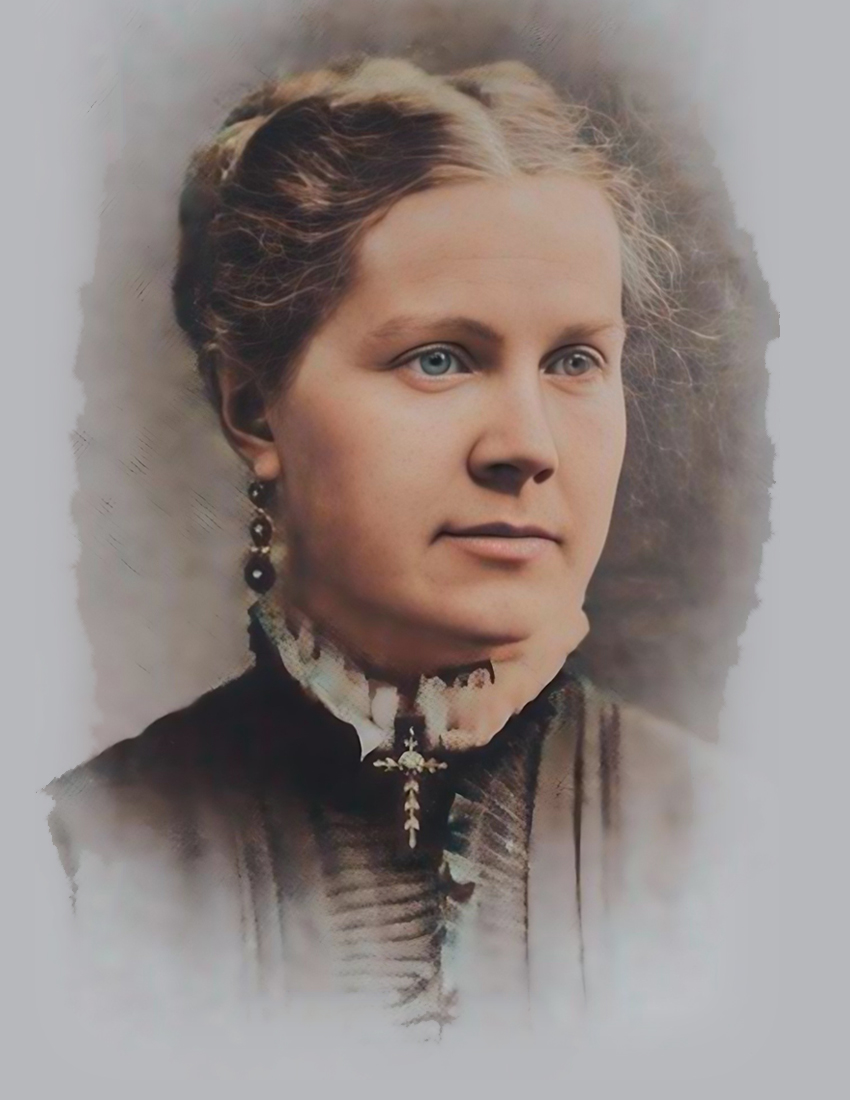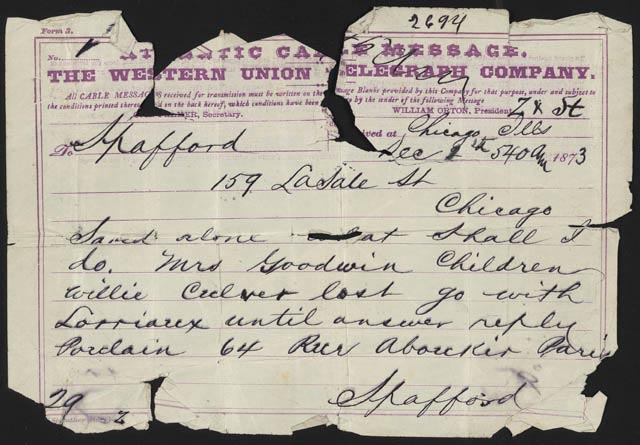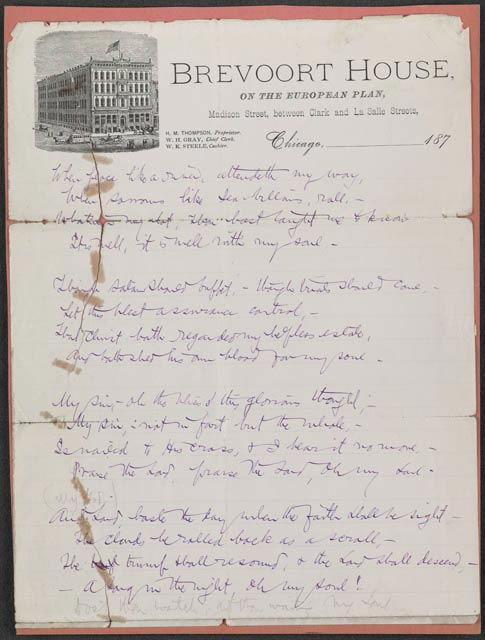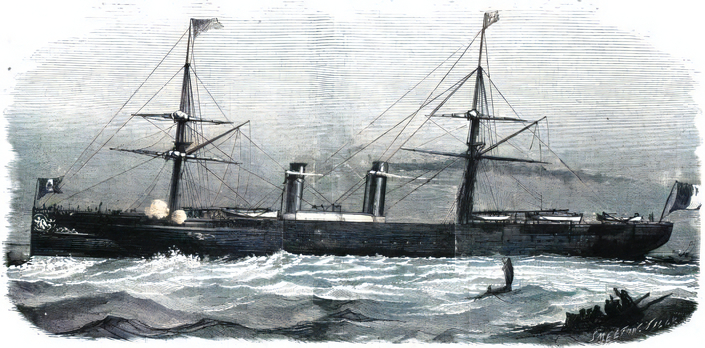Born: October 20, 1828, North Troy, NY.
Died: October 16, 1888, Jerusalem, Israel.
Buried: Jerusalem Protestant Cemetery, Jerusalem, Israel.
Horatio Spafford
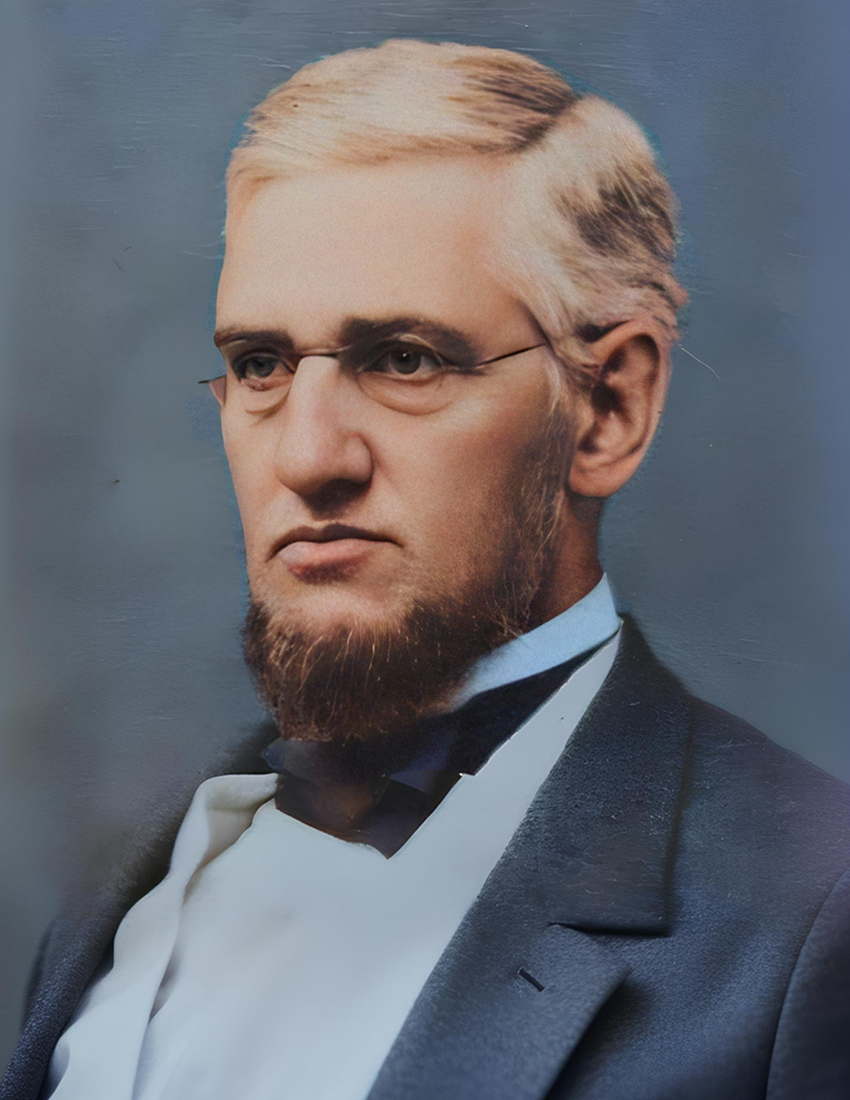
Hymns by Horatio Spafford
More About the Spaffords
Spafford’s Adopted Son Unearthed Rare Biblical Artifact
The Siloam inscription, also known as the Shiloah inscription or KAI 189, is a Hebrew inscription found in the Siloam tunnel in East Jerusalem. This tunnel, which brings water from the Gihon Spring to the Pool of Siloam, is a remarkable feat of ancient engineering. But perhaps even more remarkable is the story of the inscription’s discovery by Jacob Eliahu, the adopted son of Horatio Spafford.
How the Spaffords’ Journey Led to the Iconic American Colony in Jerusalem
In the late 19th century, a group of Americans led by Horatio and Anna Spafford embarked on a remarkable journey from Chicago to Jerusalem. Seeking solace and purpose after enduring unimaginable tragedies, they established the American Colony, a Christian utopian society that would leave an indelible mark on the Holy City.
A Life Marked by Tragedy and Faith
Horatio Spafford had it all – a thriving legal practice, a beautiful home, a loving wife and family. But in 1871, his life began to unravel. The Great Chicago Fire destroyed much of his real estate investments. Worse, scarlet fever claimed the life of his youngest child.
Desperate for renewal, Horatio decided to take his wife, Anna, and their four daughters to England for a much-needed vacation. Last minute business kept him behind in Chicago, so he sent his family ahead, promising to follow shortly.
Then came the telegram: “Saved alone.” The ship carrying his family, the Ville du Havre, had collided with another vessel and sunk. 226 people lost their lives – including all four of Spafford’s precious daughters: Annie, age 12; Maggie, 7; Bessie, 4; and 18-month old Tanetta. Only his wife Anna survived.
Daugher Bertha Spafford Vester, born after the tragedy, expains in her biography “from a watch one of the passengers carried, that stopped when the ship sank, they estimated that Mother had been in the sea for an hour. She had been rolled under and down, and as she rose unconscious to the surface a plank floated under her, saving her life.”
A Hymn Born from the Depths of Sorrow
Horatio immediately set sail to join his grieving wife. Crossing the Atlantic, the captain made careful calculations by his charts, then called him to the bridge: “This is where the shipwreck occurred.” What agony of soul Horatio must have felt as he stared down at those waters three miles deep! Yet even in that terrible moment, his faith held firm. Some accounts tell us he uttered the words, “It is well; the will of God be done.” In a letter to his wife’s half-sister, Horatio would later write:
On Thursday last we passed over the spot where she went down, in mid-ocean, the waters three miles deep. But I do not think of our dear ones there. They are safe, folded, the dear lambs.
Legend tells us that Horatio immediately penned his famous hymn right there at sea, but the truth is even more beautiful. Rather than a moment of instant inspiration, the hymn was born from years of wrestling with grief, of faith tested and refined through daily struggle.
According to Ira Sankey’s memoir (Sankey was Moody’s music director and close friend of the Spaffords) the crossing planted a seed that would bloom into poetry years later. Sankey recalls: “In 1876, when we returned to Chicago to work, I was entertained at the home of Mr. and Mrs. Spafford for a number of weeks. During that time Mr. Spafford wrote the hymn ‘It is well with my soul’ in commemoration of the death of his children.” Back in Chicago, as grief matured into hope, Horatio carefully crafted the lines that would become one of the most beloved hymns of all time:
When peace like a river attendeth my way
When sorrows like sea billows roll
Whatever my lot Thou has taught me to say
It is well it is well with my soul
The hymn may not have been written instantly at sea, but the faith it expresses was forged in that very moment when a father chose to see his daughters not in the depths below, but safe in the arms of God above.
The Spaffords: A Family Marked by Faith and Tragedy
Horatio Spafford was born to Gazetteer author Horatio Gates Spafford and Elizabeth Clark Hewitt Spafford. On September 5, 1861, Spafford married Anna Larsen of Stavanger, Norway, in Chicago. The Spaffords were supporters and friends of evangelist Dwight L. Moody.
Following the tragic sinking of the Ville du Havre, Anna gave birth to three more children, Horatio Goertner, Bertha Hedges, and Grace. But tragedy struck again when their son Horatio died of scarlet fever at the age of four in 1880. This final blow began Spafford’s move away from material success toward a lifelong spiritual pilgrimage.
The Overcomers: A Messianic Sect in Jerusalem
In August 1881, the Spaffords settled in Jerusalem as part of a group of 13 adults and three children, establishing the American Colony. Their Messianic sect, dubbed “the Overcomers” by the American press, engaged in philanthropic work among the people of Jerusalem regardless of religious affiliation.
In Jerusalem, Spafford and his wife adopted a teenager named Jacob Eliahu, born in Ramallah to a Turkish Jewish family. As a schoolboy, Jacob discovered the famous Siloam inscription.
The Legacy of “It Is Well With My Soul”
When Horatio penned his immortal hymn in 1873, he wrote from within the bounds of orthodox evangelical faith. As a Presbyterian elder and friend of D.L. Moody, his lyrics boldly proclaimed substitutionary atonement: “Christ hath…shed His own blood for my soul… My sin…is nailed to the cross.” But grief has a way of making theologians of us all, and the crushing losses that followed would lead Horatio down a path of theological searching.
The years brought more sorrow – the death of his son, Horatio Jr., in 1880 – and with it, a gradual shift in Horatio’s beliefs. The man who had once embraced hard Calvinist doctrine began exploring what some called “universalist hopes.” By the late 1870s, his views had changed enough to cause a break with Chicago’s Fullerton Avenue Presbyterian Church. Horatio came to deny the existence of a tangible hell and a personal devil, holding instead to the hope that God’s love would ultimately triumph over all, even for those now lost.
Yet for all his theological wandering, there remains no solid evidence that Horatio ever abandoned his trust in Jesus’ saving work. The hymn he wrote in 1873 still centers on Christ’s atoning blood and sin borne at the cross, and many Christian universalists of his era grounded their hope in that very same cross, arguing that Christ’s atonement would ultimately save all.
Horatio died of malaria on September 25, 1888, at the age of 59, and was buried in Mount Zion Cemetery in Jerusalem. The original manuscript of his beloved hymn contained only four verses, though his daughter Bertha later noted that a verse was added and the final line modified. Philip Bliss composed the tune and named it after the ship on which Spafford’s daughters perished: Ville du Havre.
Whatever tempest life may bring, may Horatio Spafford’s poignant hymn remind us that in Christ, the anchor holds. “It is well, it is well with my soul.”
Postscript: Over Tea and Tragedy: Elisabeth Elliot Learns the Untold Story of the Spaffords
In the aftermath of the 1967 Arab-Israeli war, Elisabeth Elliot, a renowned missionary, author, and speaker, spent ten weeks in Jerusalem. During her stay, she had the privilege of meeting Bertha Spafford Vester, the fifth daughter of Horatio Spafford, the man behind the beloved hymn “It Is Well with My Soul.” Over tea and Arab sweets, the 91-year-old Vester shared with Elliot details of her family’s story that Elliot had never heard before.
Vester recounted how her father, a wealthy Chicago businessman, had decided to sell everything and move to the Holy Land after the great Chicago fire of the 1870s. He wanted to walk in the footsteps of Jesus and grow closer to Him. As the family prepared to sail, Spafford was delayed by business matters, but he sent his wife and four daughters ahead to New York. Inexplicably, he had the purser change their cabin to one closer to the bow, a decision that would prove pivotal in the face of tragedy. The ship carrying the Spafford women collided with another vessel, and the impact occurred directly where their original cabin had been located. Had they remained in that cabin, all five would have undoubtedly perished.
Despite the purser’s fateful cabin change, the ship still sank, and Horatio received a devastating telegram from his wife: “SAVED ALONE.” Mrs. Spafford had survived, but their four beloved daughters had been lost to the sea. Vester shared how her mother described that harrowing night, how she had frantically tried to save her girls, barely brushing the hem of baby Tanetta’s gown with her fingertips before the child slipped away. Mrs. Spafford herself was miraculously rescued, found floating unconscious on a piece of debris.
When Horatio Spafford sailed to France to reunite with his grieving wife, the ship’s captain called him to the bridge. The captain pointed to his charts, revealing that they were at the very spot where the other ship had gone down, taking the lives of Spafford’s precious daughters. It was a moment of unimaginable sorrow, yet also a testament to the unwavering faith that would inspire Spafford to pen the words of the timeless hymn.
“You are spared for a purpose. You have work to do.”
In her biography Our Jerusalem, Bertha Spafford Vester recounts finding a scrap of paper on which her mother wrote her recollection of that fateful disaster on the Ville du Havre:
I had no vision during the struggle in the water at the time of the shipwreck, only the conviction that any earnest soul, brought face to face with its maker, must have; I realized that my Christianity must be real. There was no room here for self-pity, or for the practice of that Christianity that always favors and condones itself and its own, rendering innocuous the sharp two-edged sword of the Word which was intended to separate soul from spirit and the desires and thoughts and intents of the heart. This soft religion was as far removed from Christ’s practice of Christianity as east from west. Nothing but a robust Christianity could save me then and now…
Mother told me, long after, that when she came back to consciousness in the boat and knew she had been recalled to life, her first realization was complete despair. How could she face life without her children? Horrible as was her physical suffering, her mental anguish was worse. Her life had been bound up in her little girls. What was life worth now, and what could it ever be without them?
Then, she told me, it was as if a voice spoke to her. “You are spared for a purpose. You have work to do.”
In that moment of returning consciousness, she lifted her soul to God in an agony of despair and humbly dedicated her life to His service.
One of the first thoughts that came to her was a memory of Aunty Sims, pointing her finger and saying: “It’s easy to be grateful and good when you have so much, but take care that you are not a fair-weather friend to God!” That phrase repeated itself in Mother’s mind. She thought, “I won’t be a fair-weather friend to God. I will trust Him, and someday I’ll understand.”
The shipwreck of the Ville du Havre would remain one of the unexplained tragedies of the sea and its greatest disaster up until the sinking of the Lusitania. It was never determined what actually happened. There seemed no reason for the collision. Captain Robertson sighted the great steamer long in advance from the Lochearn, for it was, as has been said before, a clear night of starlight and calm. Sailing vessels were always given the right of way.

